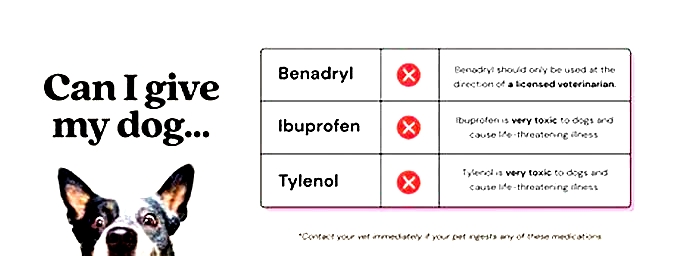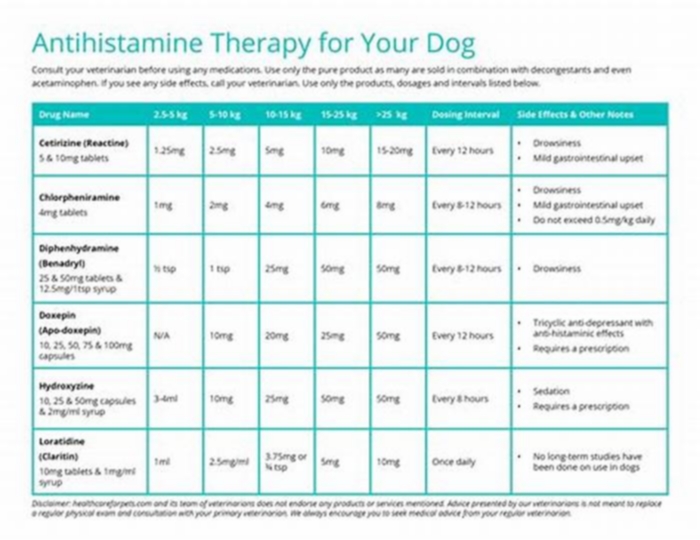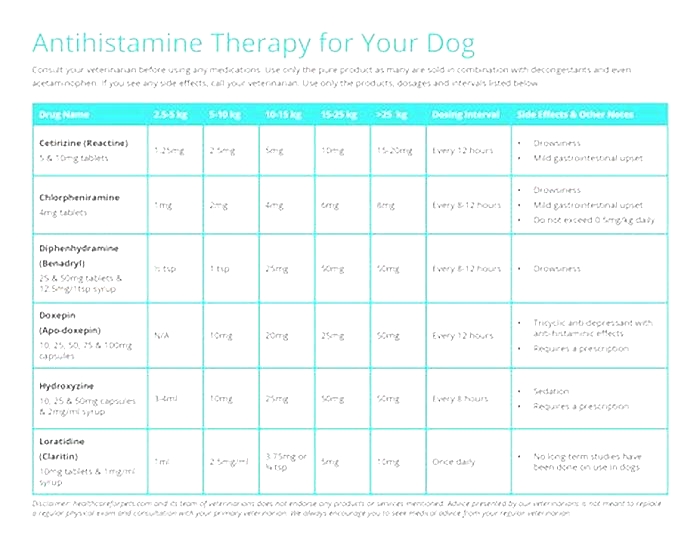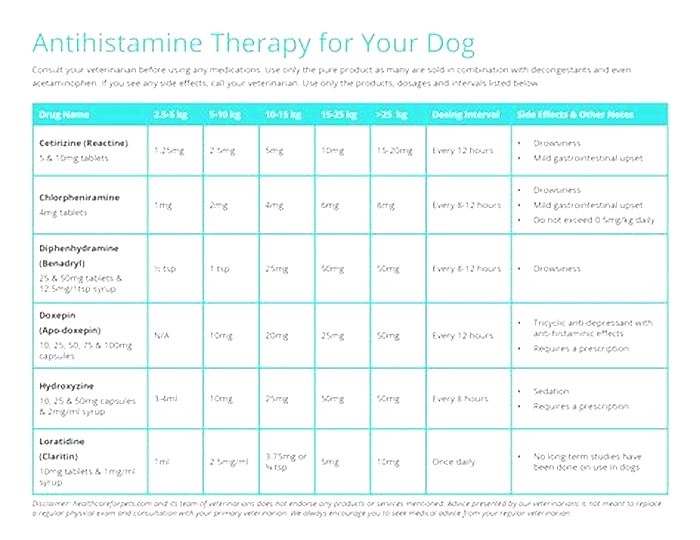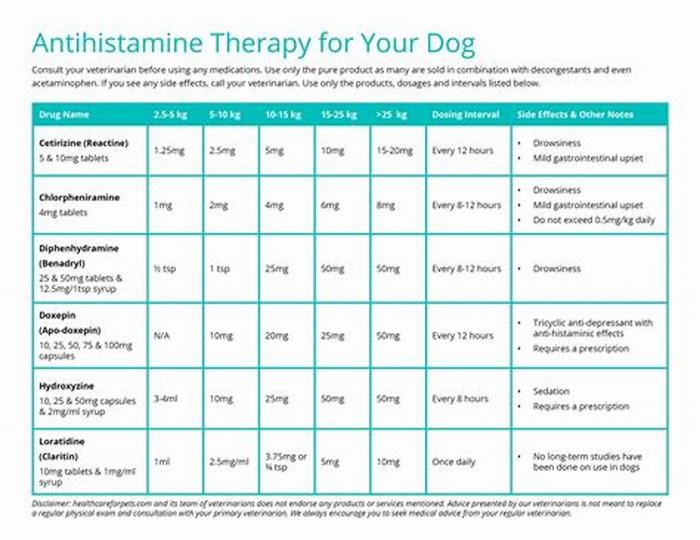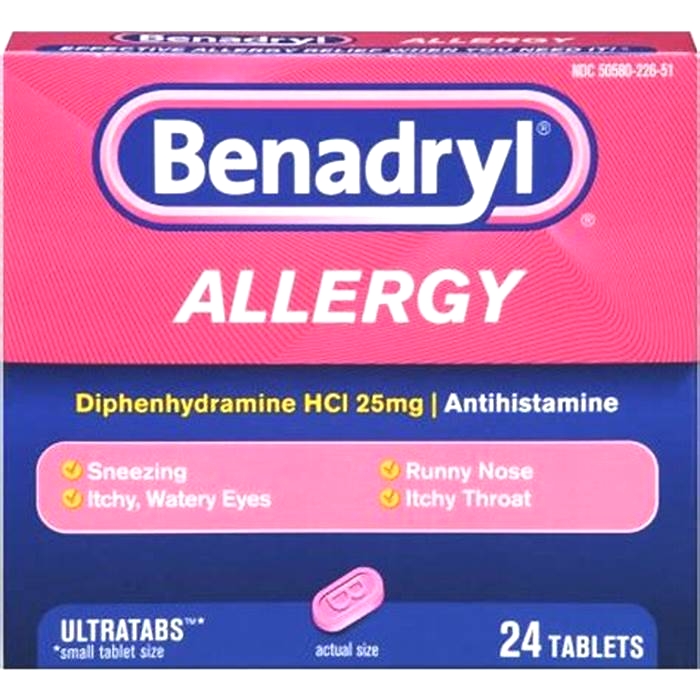How many mg of antihistamine can I give my dog
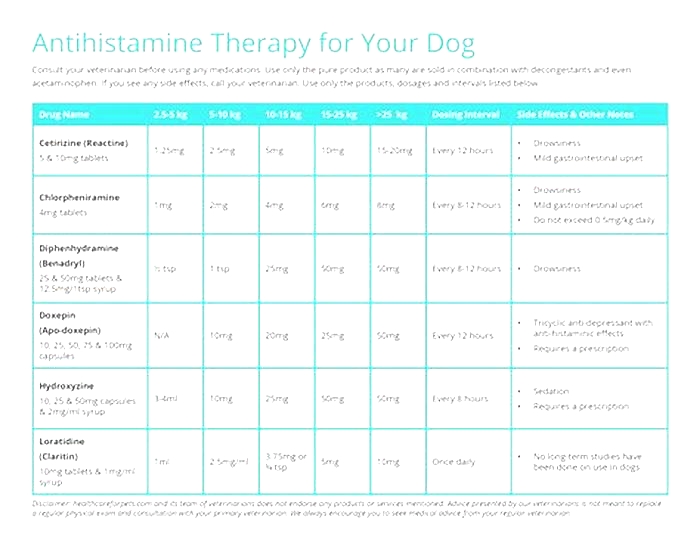
How Much Benadryl Can I Give My Dog? Is it Safe?
Are you wondering whether you can give your dog Benadryl to help with itching, allergies, or anxiety?
Benadryl (Diphenhydramine) is generally safe for most dogs when used correctly. However, before administering this medication to your furry friend, it's crucial to know the recommended dosage based on your dog's weight.
This article will serve as a comprehensive guide for how much Benadryl you can give your dog, how to calculate the proper dosage, and the potential side effects to keep an eye on.
Note: Please remember to consult a veterinarian before administering Benadryl or any other medication to your pet.
Is Benadryl Safe for Dogs?
As a licensed veterinarian, I would say Benadryl is safe for dogs when given at the appropriate dosage. It is an antihistamine that can help alleviate symptoms of allergies, such as itching, swelling, and sneezing.
However, dogs with certain medical conditions may not be good candidates for Benadryl and should only be given the medicine under the guidance of a veterinarian.
Types of Benadryl
Diphenhydraminecomes in various forms, including tablets, capsules, and liquid. Each has its own level of strength in milligrams (mg).
Benadryl is available in:
Tablets- small round tables that come in 25mg or 50mg strength.
Capsules- small capsules that also come in 25mg or 50mg strength.
Liquid- similar to other liquid medications and following a mg/mL dosing, these typically come in a strength of 12.5mg/5ml (2.5mg/ml). If you choose the liquid form, make sure that it does not contain xylitol or other active ingredients.
How Much Benadryl is Recommended for Dogs?
The general guideline for Benadryl dosage is quite straightforward:1 mg of Benadryl per pound of body weight, administered every 8 to 12 hours. This frequency helps maintain the medication's effectiveness throughout the day.
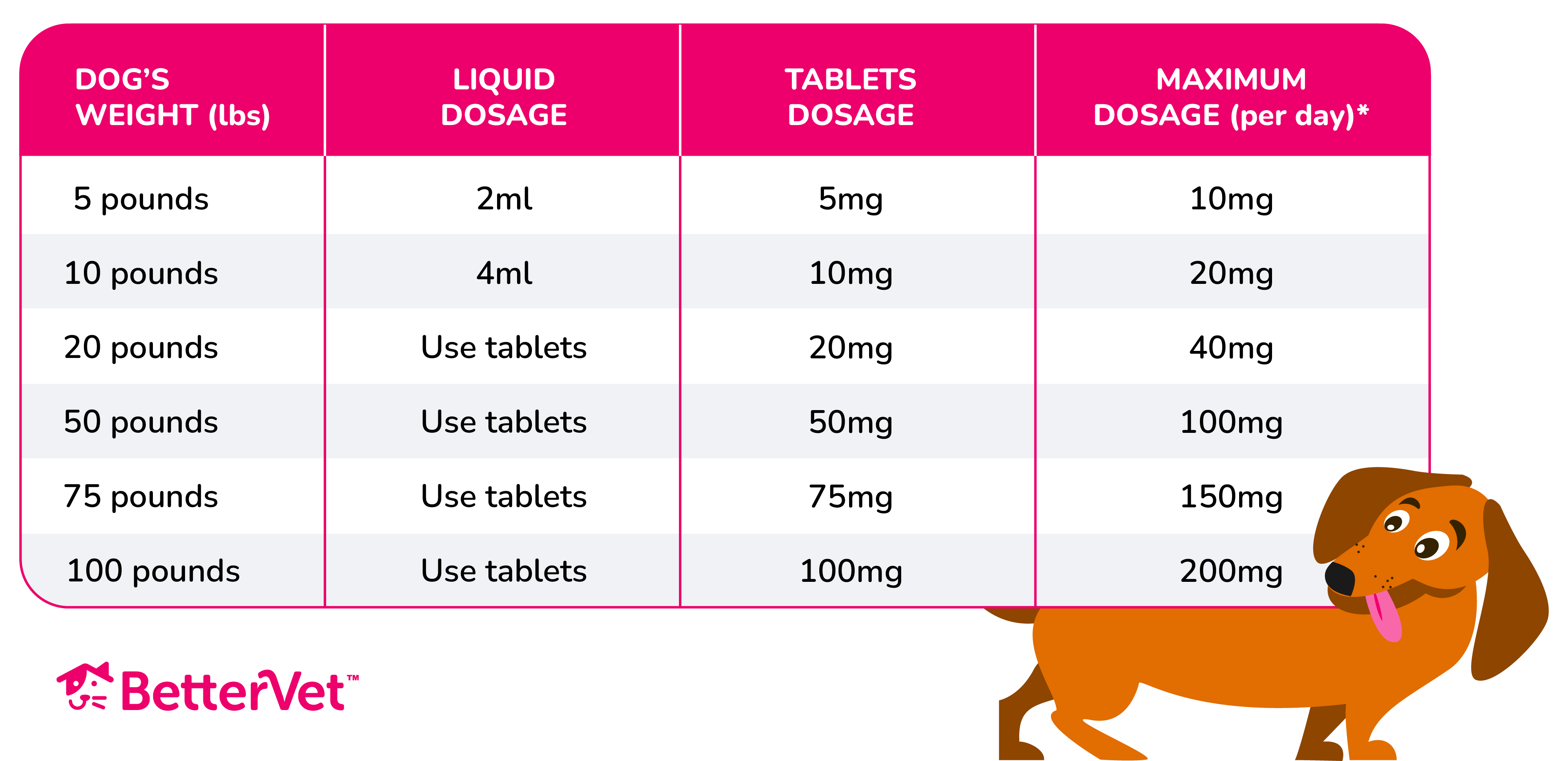
Liquid Benadryl is typically recommended for dogs weighing less than 10 pounds, as this can make it easier to achieve an accurate and appropriate dose.
For dogs weighing more than 10 pounds, most veterinarians recommend tablets, which come in 25-50 mg sizes. Achieving the appropriate dose requires breaking the tablets into quarters as closely as possible. However, it is important to note that the exact dosing will depend on your dog's individual needs and medical history.
Liquid Benadryl Dosage Formula for Dogs
If you need to calculate the appropriate liquid dosage of Benadryl for your dog, you can use a simple formula. First, divide your dog's weight in pounds by 2.5. The result will give you the appropriate dose in milliliters (ml).
For example, if your dog weighs 10 pounds, you would calculate its dosage as follows: 10lbs 2.5 = 4ml.
Once you have determined the appropriate dosage, you can measure it using a syringe or a measuring spoon. It is important to note that one teaspoon is equal to 5 ml, so if your dog requires a dose of more than one teaspoon, you will need to use multiple teaspoons to measure the appropriate amount.
Dog Benadryl Dosage by Weight Chart
Below is a table illustrating how much Benadryl you can give your dog depending on how much it weighs.
Dog Weight (lbs) | Liquid Dosage (mL)* | Tablet Dosage (mg) | Total Daily Dosage (mg) |
5 | 2 mL | 5 mg | 10 mg |
10 | 4 mL | 10 mg | 20 mg |
15 | 6 mL | 15 mg | 30 mg |
20 | 8 mL | 20 mg | 40 mg |
25 | 10 mL | 25 mg | 50 mg |
30 | 12 mL | 30 mg | 60 mg |
35 | 14 mL | 35 mg | 70 mg |
40 | 16 mL | 40 mg | 80 mg |
45 | 18 mL | 45 mg | 90 mg |
50 | 20 mL | 50 mg | 100 mg |
55 | 22 mL | 55 mg | 110 mg |
60 | 24 mL | 60 mg | 120 mg |
65 | 26 mL | 65 mg | 130 mg |
70 | 28 mL | 70 mg | 140 mg |
75 | 30 mL | 75 mg | 150 mg |
*Assuming a liquid concentration of 12.5mg/5mL, which is a common formulation.
Can You Use Benadryl to Treat Allergies in Dogs?
Yes, Benadryl is effective for treating a range of allergy symptoms in dogs. Whether it'sseasonal allergiesor reactions to an environmental irritant, Benadryl can offer quick relief, making it a go-to in my practice for immediate symptom management.
Here are the allergy symptoms Benadryl can help treat in dogs:
Sneezing: Reduces sneezing caused by environmental allergens.
Reverse Sneezing: Can alleviate episodes of reverse sneezing, which are often benign but can be triggered by irritants or allergens.
Red Eyes: Helps soothe red, irritated eyes resulting from allergic reactions.
Watery Eyes: Reduces excessive tear production associated with allergies.
Itching: Eases skin itchiness due to allergies, helping to prevent scratching that can lead to skin infections.
Hives: Reduces the occurrence of hives secondary to an allergic reaction.
Skin Allergies: Offers relief from discomfort caused by allergic dermatitis and other skin allergies.
Seasonal Allergies: Mitigates symptoms associated with seasonal allergies, such as pollen.
If you are unsure if Benadryl is the right medication to treat your dogs allergy-related symptoms,schedule a virtual vet visitwith one of our online veterinarians.
What Else Can You Use Benadryl for in Dogs?
In addition to its use in managing allergy symptoms, Benadryl can have a range of other applications when used in dogs.
Some use cases of Benadryl in dogs may include:
It is also worth noting that while Benadryl can be an effective tool in managing specific health issues in dogs, it may not be appropriate for every situation, and other treatments or interventions may be necessary.
Common Side Effects of Benadryl in Dogs
When administering Benadryl, themost frequently observed side effect is drowsiness. This is due to thesedative properties of diphenhydramine, the active ingredient in Benadryl.
While this can be beneficial in calming allergic reactions, it's important to monitor your pet to ensure they are comfortably resting and not overly sedated.
When giving your dog Benadryl, watch for these side effects:
Drowsiness: The most common effect, due to Benadryl's sedating properties.
Dry Mouth: Increased thirst and frequent water seeking are signs to look out for.
Nausea and Vomiting: Less common, but some dogs may become nauseous.
Increased Heart Rate: A serious side effect that requires immediate veterinary attention.
Rapid Breathing: Another critical sign indicating the medication may not be well-tolerated.
Urinary Retention: Difficulty urinating, a less common but important side effect to monitor.
Can a Dog Overdose on Benadryl?
Yes, a dog can indeed overdose on Benadryl. Overdosing can lead to severe health complications. It's crucial to adhere strictly to the recommended dosage guidelines and consult with your veterinarian to prevent such a situation.
Here are thesigns of a Benadryl overdose in dogsthat you should be aware of:
Rapid Heartbeat: An increase in heart rate beyond the normal range.
Dilated Pupils: Noticeable enlargement of the pupils.
Agitation or Hyperactivity: Uncharacteristic restlessness or increased activity.
Constipation: A noticeable decrease in or absence of bowel movements.
Seizures:Convulsions or severe twitching, which are medical emergencies.
Dry Mouth: Significantly reduced saliva production or extreme thirst.
Urinary Retention: Difficulty urinating or an inability to urinate.
If you observe any of these signs in your dog after administering Benadryl, it's imperative toseek emergency veterinary care immediately.
An overdose requires prompt medical attention to mitigate the risks and ensure your pet's safety and well-being.
Conclusion
In summary, Benadryl (diphenhydramine) can be a helpful and safe medication for treating mild itching, to be used as a mild sedative, and to prevent acute allergic reactions in dogs.
Common side effects of Benadryl in dogs include sleepiness and gastrointestinal symptoms but most dogs will tolerate the medication well.
If you have concerns about giving Benadryl to your dog or if your dog experiences any adverse effects, consult with your veterinarian.
Frequently Asked Questions
How long does Benadryl last in dogs?
Benadryl typically lasts 6-8 hours in dogs. However, the actual duration of effect may vary depending on factors such as your dog's weight, age, and health status.
How long does it take for Benadryl to work on dogs?
Benadryl typically takes effect within 30 minutes to an hour of administration. However, this time may vary depending on your dog's weight, age, and health status.
Can dogs be allergic to Benadryl?
Yes, dogs can be allergic to Benadryl or any other medication. While it is generally well-tolerated, some dogs may experience allergic reactions to Benadryl, such as itching, hives, swelling, or difficulty breathing.
Can I give my dog Benadryl?
Benadryl is commonly used in dogs with mild-to-moderate allergies. It can help relieve symptoms like itching, sneezing, and watery eyes. However, it's important to talk to your vet before giving your dog Benadryl, as it can interact with other medications or health conditions.
The recommended dosage to administer the medication is typically 0.9 to 1.8 milligrams per pound of your dog's body weight, given 1-2 times per day. Always use the appropriate formulation and dosage for your pet's size and weight, and follow your vet's instructions carefully.
Can I give my dog Benadryl for itching?
Yes, you can give your dog Benadryl for itching. Benadryl contains an antihistamine called diphenhydramine, which can help alleviate itching in dogs.
Can I give my dog human Benadryl?
Yes. Benadryl is an over-the-counter medication that is labeled for humans but is generally considered safe for dogs in the appropriate dosage. Always consult with your veterinarian before giving your dog any medication.
Can I give my dog Benadryl every day?
It is generally safe to give your dog Benadryl daily for short periods, as directed by your veterinarian. However, if you plan to give your dog Benadryl for longer than a few days, you should consult your vet to discuss potential risks or concerns.
Can I use Benadryl to sedate my dog for travel?
While Benadryl may have a mild sedative effect on some dogs, veterinarians typically do not recommend it as a primary sedation method for travel. Instead, discussing options for safe and effective sedation with your veterinarian would be best.
How much Benadryl to give a 50 LB dog?
It is generally recommended to provide two 25-milligram tablets, but it's crucial to consult with a veterinarian beforehand to ensure that Benadryl is suitable for your dog's specific requirements and to verify the correct dosage based on your dog's weight and other health considerations.
Read more: 10 Tips for Traveling with Your Pet
Sources and References
Worth, A.C., Wismer, T.A. and Dorman, D.C., 2016. Diphenhydramine exposure in dogs: 621 cases (20082013). Journal of the American Veterinary Medical Association, 249(1), pp.77-82.
Loew, E.R., MacMILLAN, R.O.B.E.R.T. and Kaiser, M.E., 1946. The anti-histamine properties of Benadryl, -dimethylaminoethyl benzhydryl ether hydrochloride. Journal of Pharmacology and Experimental Therapeutics, 86(3), pp.229-238.
Cortinovis, C., Pizzo, F. and Caloni, F., 2015. Poisoning of dogs and cats by drugs intended for human use. The Veterinary Journal, 203(1), pp.52-58.
Benadryl Dosage For Dogs: Safe Guidelines & Dosage Charts
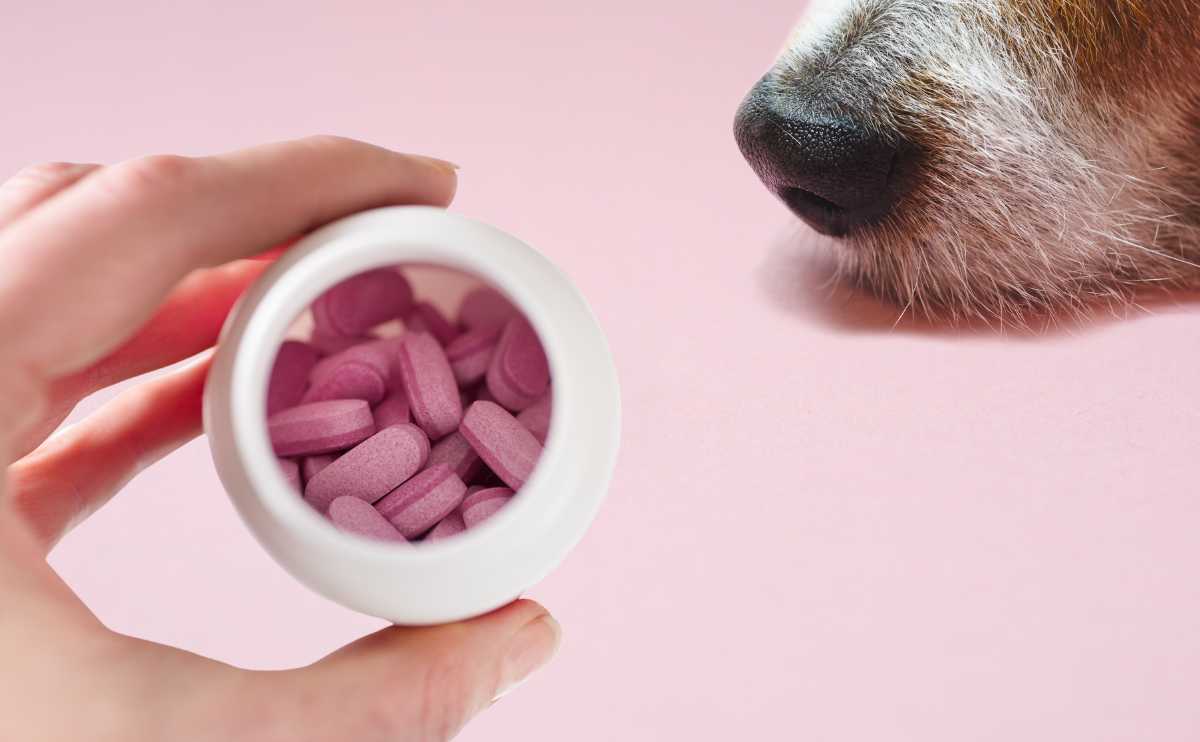
Benadryl (diphenhydramine HCI) is one of the very few human over-the-counter medications that are generally considered safe for dogs and that veterinarians often recommend. Many pup owners find this antihistamine helpful in relieving mild allergic reactions, mild itchy skin, and motion sickness in their canine counterparts. The widely accepted guideline is 1mg per pound of your dogs weight.
But before you share the Benadryl in your medicine cabinet with your dog, its important to know a few details to ensure your pups safety. Well tell you which forms of Benadryl are safe to administer to your pup, give you a handy dosage chart, and answer some other questions you may have about giving this OTC medication to your furry friend.
How Much Benadryl Can I Give My Dog?
While Benadryl is safe for most dogs, please remember that its so important to discuss giving it or any medication or supplement with your veterinarian. Your vet can make sure any non-prescribed product, like Benadryl, is safe for your dogs specific health conditions and will help give you dosing guidance.
With that said, the general dosing guide for Benadryl is pretty straightforward. Most vets and experts recommended a standard dose of roughly 1mg/pound. The standard Benadryl youll find in stores is 25mg/tablet for adult Benadryl. You can also use Childrens Liquid Benadryl, which is 12.5mg/5 ml. However, vets usually only recommend Childrens Liquid Benadryl for dogs under 10 pounds because its easier to achieve an accurate dose vs. tablets.
You can increase this dose a bit if needed, but be sure to get your vets okay. Benadryl is safe to give to dogs every eight to 12 hours (one to three times per day) in the short term. But for long-term use, its a good idea to consult your vet.
Benadryl For Dogs: Dosage By Weight
| Dogs Weight | Benadryl Dosage |
|---|---|
| 5 lbs | 5 mg 2 ml Childrens Benadryl |
| 10 lbs | 10 mg 4 ml Childrens Benadryl |
| 20 lbs | 20 mg 3/4 tablet |
| 30 lbs | 30mg- 1 tablet |
| 40 lbs | 40mg- 1.5 tablets |
| 50 lbs | 50mg- 2 tablets |
| 60 lbs | 60mg- 2.5 tablets |
| 70 lbs | 70mg- 2.5 tablets |
| 80 lbs | 80mg- 3 tablets |
| 90 lbs | 90-100mg- 3.5-4 tablets |
Did You Know?
When comparing Benadryl dosage levels for dogs to what adult humans can take, you may wonder why recommended doses for our canine counterparts are so high. Theres a simple reason for this. Dogs metabolize Benadryl and other antihistamines much faster than humans.
Childrens Liquid Benadryl For Dogs Dosage Chart
In general, vets usually recommend tablets for dogs over 10 pounds. However, if your dog loathes taking pills or you have trouble cutting up tablets, Childrens Liquid Benadryl is also safe for dogs of all sizes.
| Dogs Weight | Childrens Liquid Benadryl Dosage |
|---|---|
| 5 lbs | 2 ml |
| 10 lbs | 4 ml |
| 20 lbs | 8 ml |
| 30 lbs | 12 ml |
| 40 lbs | 16 ml |
| 50 lbs | 20 ml |
| 60 lbs | 24 ml |
| 70 lbs | 28 ml |
| 80 lbs | 32 ml |
| 90 lbs | 36 ml |
| 100 lbs | 40 ml |
Types Of Benadryl To Avoid Giving Your Dog
Diphenhydraminehydrochloride is the active ingredient in American Benadryl (found in the U.S., Canada, Singapore, Taiwan, Italy, and Hong Kong). However, in the U.K. and Denmark, the active ingredients areacrivastinein Benadryl Allergy Relief andcetirizinein Benadryl Once a Day. Limited information exists on acrivastine and cetirizine use in dogs, soif youre in Europe, make sure the active ingredient is diphenhydramine, the only form of Benadryl thats considered safe for dogs.
Regarding American Benadryl, you should avoid giving your pup the following forms:
- Liqui-Gels: Capsules are nearly impossible to break up to get the appropriate dose. Theyre also absorbed differently in dogs than in humans so this may cause issues with your pups dosage.
- Adult Liquid Benadryl: contains alcohol, which is toxic to dogs.
- Benadryl Allergy Plus Congestion:This Benadryl formula contains phenylephrine HCl, a common decongestant in human cold medications thats not safe for dogs.
- Extra Strength: While extra strength Benadryl is safe for dogs, it comes in 50 mg/tablet, and most vet dosing guidelines are for the 25 mg/tablet standard Benadryl. So, youll have to do your own calculations. To ensure your pups safety, its best to stick with vet guidelines.
Use Benadryl Cautiously With Some Dogs
Benadryl can make some conditions worse, so you should use caution if your pup suffers from any of the following health issues. Be sure to discuss Benadryl use with your veterinarian in these cases and if theres a possibility of adverse interactions with any other medication your furry friend is taking.
- Pregnancy or nursing
- Glaucoma
- Dry eye
- Heart disease
- High blood pressure
- Chronic obstructive pulmonary disease (COPD)
Our Personal Experience With Benadryl And Dogs
Several members of our team occasionally give our pups Benadryl under our veterinarians recommendations. Weve all found it to be safe and effective.

Lily got a hornet sting on her left back leg while on a walk. It swelled up quickly. When we got home, we immediately gave her Benadryl and monitored her symptoms closely for any changes. Additionally, we applied ice for 10 minutes once an hour. While she was still limping a few hours later, this treatment combo helped reduce some of the swelling and discomfort. Thankfully, within two days, Lily was feeling significantly better.
Michelle Schenker, co-founder of Canine Journal and pet parent of two rescue dogs
Frequently Asked Questions
How Often Can I Give My Dog Benadryl?
Typically, the effects of Benadryl last in your furry friends system for six to eight hours. But most vets and experts recommend giving your pup Benadryl every eight to 12 hours to account for differences in metabolism.
How Long Does It Take For Benadryl To Kick In For Dogs?
In most cases, it only takes about 1/2 hour to one hour for Benadryl to become effective for dogs. However, this time frame may vary depending on the dose you gave your pup as well as her age, weight, and health status.
Are There Side Effects & Overdosing Concerns With Benadryl Use In Dogs?
Most dogs tolerate Benadryl extremely well, and the risk of overdose is low. Side effects and overdosing are rare, but see our ultimate guide on Benadryl use in dogs to learn more about both of these concerns, as well as more detailed information about how Benadryl can help your pup.
Is Benadryl Effective For Dog Anxiety?
The sedative effects of Benadryl may help some dogs with situational anxiety, such as for fireworks, thunderstorms, or car rides. However, Benadryl can cause hyperactivity rather than sedation in some dogs. So many experts believe you have better options for anxiety relief for your furry friend. Alternatives to Benadryl include CBD oil, dog-specific calming supplements, or prescription medications for chronic anxiety.
Can I Use Childrens Chewable Tablets For My Dog?
Yes, Childrens Chewable Benadryl tablets are safe for dogs. Theyre ideal for smaller dogs. A full chewable childrens tablet contains 12.5 mg of diphenhydramine, so you can cut one in half for dogs weighing less than 10 pounds as an easy alternative to Childrens Liquid Benadryl.
Alternatives To Benadryl In Treating Chronic Allergy Symptoms
One of the most popular uses of Benadryl in dogs is to treat allergic reactions. This application can be extremely effective for temporary or short-term allergy symptoms, such as reactions to an insect bite or bee sting or mild seasonal allergies from pollen. However, Benadryl isnt your best line of defense if your pup suffers from long-term allergy problems.
If youve noticed that your pup is incessantly scratching her skin no matter what time of year, she could have a food intolerance or allergies to household environmental factors, such as dust mites or mold. For chronic allergic symptoms, which can include itchy, irritated skin and/or digestive issues, you may want to consider dog allergy supplements,daily medications, or monthly injections.
However, for chronic allergy symptoms, we recommend first consulting your veterinarian. Alternatively, you can give your pup anat-home dog allergy test kit. Thesekits test forintolerances to many food and environmental factors.Then, you can share these results with your vet to work on further diagnostics and a treatment plan.
Tagged With: Allergies, Medication
